The choice of heating radiators for a private house:
Many of us, planning the construction of our housing or its large-scale reconstruction, are interested in which heating radiators are better for a private house. And, of course, it is impossible to give an unequivocal answer to this question - too much depends both on financial possibilities and personal preferences - we still give some recommendations on the selection of batteries.
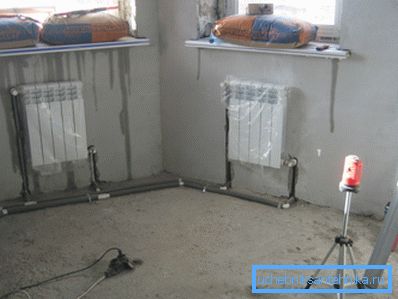
Features of heat networks in a private house
Houses, in contrast to apartments, are overwhelmingly equipped with autonomous heating systems. Accordingly, trying to select the best heating radiators for a private house, we should first of all consider the parameters of these systems.
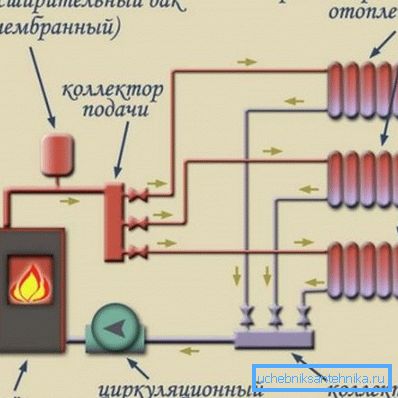
We will try to analyze the key features in the table:
| Key factor | Effect on radiator selection |
| Low pressure | As a rule, in a private house the coolant in the pipes is under relatively low pressure. On the one hand, this necessitates the use of circulating pumps, but on the other hand, it reduces the load on pipes and radiator tanks, extending their service life. |
| No water hammer | Since the system eliminates water hammer, there is no need to install batteries with a huge margin of safety. It is quite possible to confine light thin-walled structures, which are characterized by high heat transfer. |
| Small length of communications | Compared to an apartment building, in a private dwelling the distance from the boiler or stove to the radiator will be minimal. Accordingly, the heat loss will also decrease, because it is worth buying batteries, designed to work with high-temperature coolant. |
| Using a small amount of coolant | The volume of water poured into the system is quite small. This means that we can not only ensure a decent cleaning by protecting the radiators from damage by abrasive particles, but also replace part of the liquid with antifreeze or ethyl alcohol. Despite the fact that the price of such additives is very substantial, their use protects pipes and radiators from freezing during long-term shutdown of the boiler, and also allows for increased heat transfer. |
| Significant heating area | The area of the house is usually larger than the area of the apartment, so we have to warm very extensive spaces. Accordingly, deciding which heating radiators are better for the home, we should give preference to those models that will provide the most efficient heating at the lowest cost. |
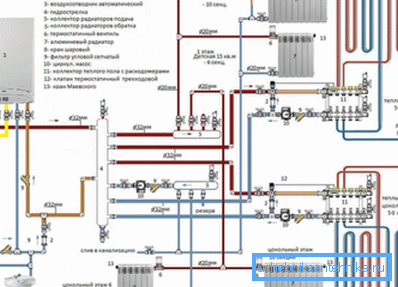
As can be seen from the table, we will have to analyze the range of the market quite seriously. That is why below we will try to provide information on the most commonly used types of batteries, which can facilitate your choice of radiators for a private house.
Radiator material
Cast iron
The key parameter determining the functionality of the radiator is the material of its manufacture. In addition to the actual heat transfer, the type of material used imposes restrictions on the product design, so that certain technological solutions can be realized only when using a certain metal.
Previously, both for installation in apartment buildings and for heating private dwellings, predominantly cast iron batteries were used. They were produced by injection molding, and were quite cumbersome designs.
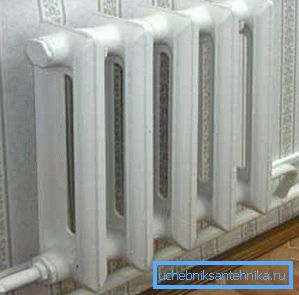
The following features are characteristic of cast iron products:
- The material has good resistance to corrosion and pressure, but it does not tolerate shock impacts. This drawback is especially relevant for products of the mid-to-late 20th century: low-grade cast iron, which often cracked on impact, began to be used for casting radiator sections at that time.
- Heat transfer from cast iron is relatively low, which makes its use not very efficient. At the same time, such a battery will give up the accumulated heat for a long time, because at night or for a long time the heating kennel can be turned off.
- Another disadvantage is a significant mass. Molded cast iron radiators can be installed either on floor fasteners or on massive wall hooks. At the same time, the bearing surface must be very durable: neither the frame houses, nor the buildings of foam concrete will not withstand such a load.
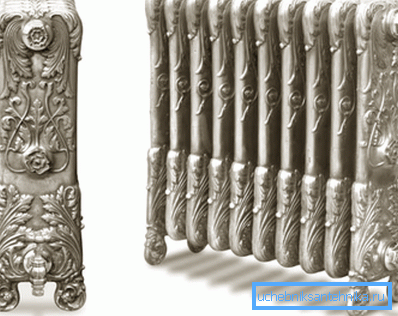
- The advantages include design products. Today, many manufacturers are focused on the production of cast iron batteries in the premium segment, and these models compensate for the lack of heating efficiency with an attractive anti-antique look.
Note! The cost of vintage cast-iron radiators is rarely less than 10 thousand rubles, because the budget such a purchase can not be called.
Steel
Choosing which radiator is better for a private house, many experts stop at tubular and panel steel products.
They have their advantages:

- First, in terms of heat transfer, they are superior to cast iron, and quite significantly.
- Secondly, they weigh much less.
- Third, the design of such batteries does not involve the use of thick-walled pipes, because the surface warms up very quickly.
If we talk about the shortcomings of steel, they are as follows:
- The material not only heats up quickly, but also quickly cools, so that the boiler will have to be constantly heated.
Note! This is typical for all other models of radiators, ranging from aluminum to bimetallic.
- When it comes into contact with water, the steel will rust, so the radiators should be cleaned regularly, and when there are signs of weakening of the walls, they should be replaced immediately.
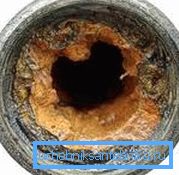
Aluminum
According to a number of heat engineers, the best radiators for heating a private house (meaning price / quality ratio) are made of aluminum.
This has its reason:
- Aluminum conducts heat very well, because the heat dissipation of the battery will be higher than that of other metal products.
- The material does not rust, which allows it to be used for a long time.
- Externally, aluminum radiators look quite attractive, although they do not always fit into the interior of a private house.
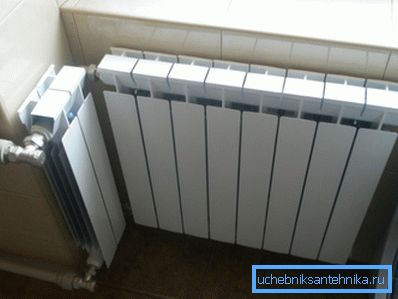
- As for the relatively low resistance to pressure drops, here this characteristic is not a disadvantage: as we noted above, water hammer in the network is practically excluded.
- The main difficulty in using aluminum radiators is water treatment: before pouring coolant into the circuits, it is necessary to reduce its alkalinity. Otherwise, plaque will accumulate on the walls of the batteries, and the radiators themselves will begin to undergo electrochemical corrosion.
Copper
Considering which heating radiators for a wooden house are better from the point of view of not only functionality, but also design, you should not lose sight of the copper models:
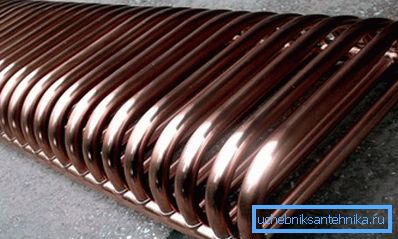
- Of course, copper is very expensive, but it also provides excellent heat transfer, so there will always be heat in the house.
- Tanks of copper batteries are not subject to corrosion, because they will serve for a long time.
Tip! To avoid accumulation of deposits, it is necessary to build a particle filter into the pipes. If this is not done, a suspension with abrasive properties will scratch the walls of the pipes, making them rough.
- Finally, copper radiators look just fine, and the appearance of polished (or patina-coated) metal is perfectly combined with wooden wall cladding.
Bimetallic models
If we talk only about functionality, then the best heating radiators for the house are bimetallic:
- These products combine the significant strength and reliability of steel or copper pipes with good heat transfer of aluminum panels.
- In this case, aluminum is not in contact with water, which protects it from alkaline corrosion.
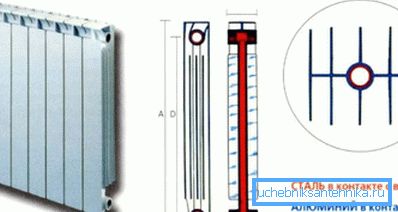
- On the other hand, the cost of such products is quite high, so that not every owner of a private house can afford the installation of bimetallic radiators.
Performance selection
The calculation of the total thermal capacity of the battery
When looking for answers to the question of which radiator is best to choose for a private house, you should not be limited to analyzing the material and comparing the appearance of models. Batteries should heat the room as efficiently as possible, and therefore you need to purchase products with sufficient heat output.
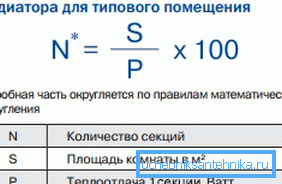
As a rule, the equipment manual contains information on its heat transfer, so in order to calculate the purchase volume, we need to determine the heating need of our house.
Note! For sectional radiators, heat transfer is indicated based on one section, for panel models - on the whole product.
This value is quite simply calculated by hand:
- You can use the simplest proportion: 100m of heat from batteries are needed per 1m2 area. Of course, this calculation is very approximate, but it gives a fairly complete idea of the order of numbers.
- There is a more accurate method. To determine the heat consumption, we multiply the volume of the room in cubic meters by 41 W (the standard coefficient for central Russia).
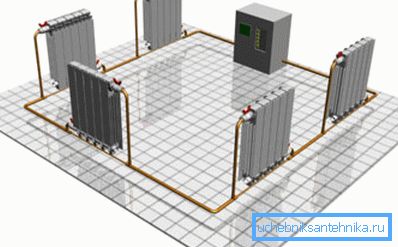
- The resulting value is divided by the heat transfer of the battery, and we get the desired number of radiators for the selected room. It is better to round the number in a big way, because the power reserve does not hurt!
Additional tips
The above recommendations are relevant to the interior.
If the room has windows facing the street, or other objects that are a source of heat loss, it is worth adjusting the power consumption:
- For rooms with a window and two outer walls, add 20%.
- For rooms with two windows and two external walls - 30%.
- If the windows are facing north or northeast - 10%.
- If radiators are planned to be installed in wall niches - 5%.
- If you plan to use protective screens for batteries - from 15 to 20%.

Only by summing all these factors, we can find the optimal number of batteries, and the house will not be cold even during the harsh winter months.
Conclusion
Information on how to choose a heating radiator for a private house will be useful not only for professional builders and heating engineers. Having the necessary knowledge, as well as applying the recommendations set forth in the video in this article, even a novice can understand the features of various models and buy heating devices that will heat his house for a long time.